JNSL Journal for Northwest Semitic Languages JSOT Journal for the Study of the Old Testament. JSOTSup Journal for the Study of the Old Testament Supplement Series JSPSup Journal for the Study of the Pseudepigrapha Supplement Series JSS Journal of Semitic Studies.
INTRODUCTION
Should the verbal parallels in Joel have any greater significance for the overall message of the book of Joel. Theodicy and the Character of YHWH in Allusions to Exodus 34:6-7 in the Book of the Twelve," JETS 61, no. James Nogalski, Literary Antecedents of the Book of the Twelve, BZAW 217 (Berlin: Walter de Gruyter, 1993); Nogalski, Editorial Processes in the Book of the Twelve, BZAW 218 (Berlin: Walter de Gruyter, 1993).
METHODOLOGY
24 The role of the editor in producing the final form of the book of the Twelve is discussed below. My study focuses on the reuse of the OT in the final form of Joel. 44 Edgar Conrad, “Forming the Twelve and Forming Canon,” in Thematic Threads in the Book of the Twelve, ed.
Bergman Kline, "The Day of God in the Death and Resurrection of Christ," JETS 48, no. And Wolfe has reconstructed no fewer than thirteen editorial layers in the Book of Twelve. 63 Aaron Schart, “The First Section of the Book of the Twelve Prophets: Hosea–Joel–Amos,”.
As noted above, Joel is often used as an integral part of redactional theories about the Book of the Twelve. An Examination of the Basis of Typology in the Old Testament,” in The Right Lesson from the Wrong Texts. The plague of locusts should not be understood as the day of the Lord, but as one.
She notes that (a) God may use them as agents of punishment, (b) they are portrayed as part of the community that calls out to God, and (c) they are recipients of God's mercy.
For example, Exodus depicts the incomparable nature of the plague of locusts with twelve words (ךיתבאתובאוךיתבאואר־אל .. ה ), while Joel uses only six (ימיב םאוםכימיב תאזהתיה א. There was a specific purpose of the plague on Egypt, and Joel also argues) . that the contagion has meaning in its day to be recognized. In the Egyptian plague narrative, the locusts are the eighth plague, quickly followed by darkness (Exodus and then the climactic tenth plague, the death of the firstborn (Ex.
Joel also laconically describes the cleaning work of the locusts without mentioning seven previous plagues. He specifically points out that Judah's current situation is similar to that of Egypt at the time of the eighth plague. In other words, one cannot easily separate the darkness and the Day of the Lord in Joel as the ninth and tenth plagues are distinct.
Dozemen argues that even in the book of Exodus there is a connection between the Day of the Lord motif and the tenth plague, "the locusts are a sign of future events representing the terrible Day of Yahweh for the Egyptians."24 . Joel's answer would be that they indicate that Judah currently stands in the place of Egypt at the time of the eighth plague and awaits a final, climactic disaster, namely the Day of the Lord.
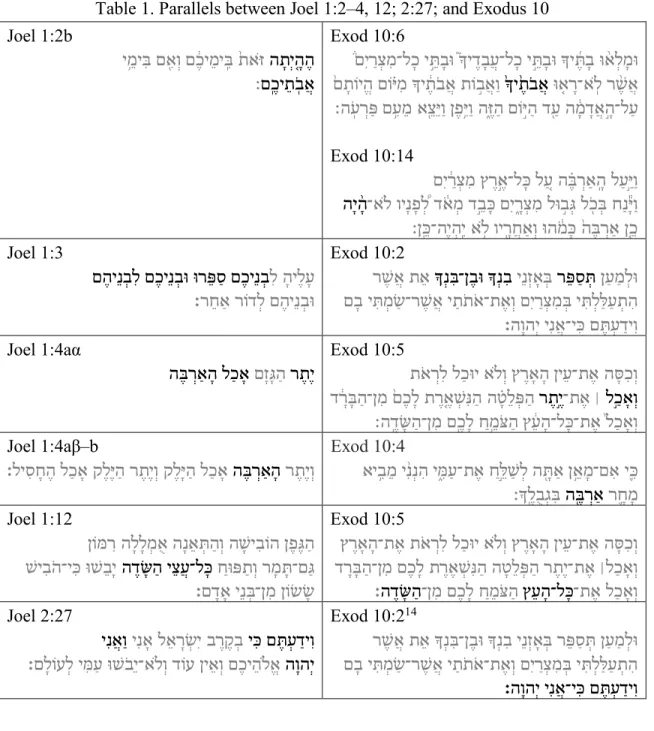
A number of the parallels between Psalm 78 and Joel 1 are also shared with Exodus 10, such as the verb רפס and the command to teach one's sons. Likewise, the parallel between Joel and Psalm 78 to tell the succeeding generation (ונרחא רודל/רחארודל) can also be understood as a formula of the didactic genre. He did this by adopting the description of the destructive effect of the hail found in both Psalm 78:47 and 105:33.
In Joel's description of the locust plague, it is clear that he drew from Exodus. 45 Bergler notes the different order of the wounds in Pss 78 and 105 and concludes that there are different traditions. The plague of locusts played an important role in such a retelling of God's mighty works in Israel's history.
Joel creatively enhanced the didactic function of Israel's historical liturgy by reversing the purpose of the locust plague and presenting his contemporaries as in the place of Egypt. In short, a reader who recognizes only an allusion to Exodus 10 will have most of the elements to understand Joel's rhetorical and didactic intent in referring to the plague of locusts.
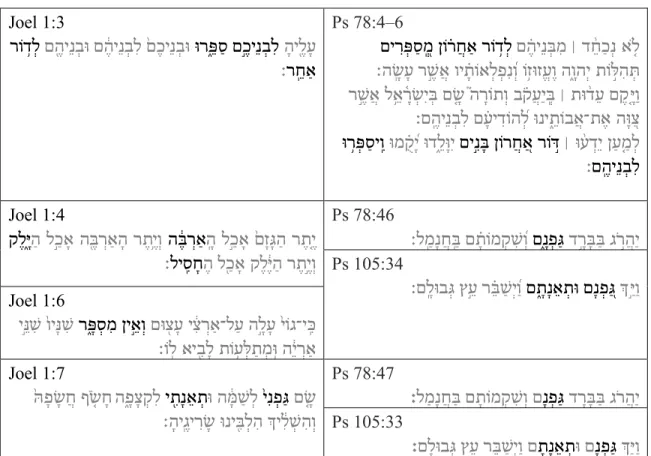
That is, the exodus is intimately connected with covenant theology, specifically the gift of the land. Covenant blessing and covenant cursing are experienced in the land, but the final curse would remove the people from the covenant gift of the promised land. 58 Some, like Barton, argue that Joel is here the referent of the pronominal suffix.
This indicates that the ancient translators understood the referent of the pronominal suffix 1cs in the MT as YHWH. Mention of the plague of locusts is one of the covenantal curses listed in Deuteronomy (Deuteronomy 28:38). The plague of locusts is not explicitly connected with the plagues of Egypt in Deuteronomy 28, but the curses of the same type as the plagues of Egypt are generally expressed.
Both Deuteronomy 28 and Exodus 10 contain the term הברא for the locust plague, one of the terms Joel used. Moreover, such a text expresses the connection of the motif of exodus with the motif of the covenant since Deuteronomy 8:7 refers to the entry into the land.60.

Admittedly, many of the parallels between Joel 1 and 1 Kings 8 are very general motifs and lack specific verbal parallels to support a literary relationship. The most significant and unique parallel is the connection of the temple with the supplication of. One strong evidence is that, of the seven scenarios raised by Solomon, Joel compares four of them: (1) drought, (2) plague of locusts, (3) enemy invasion and (4) exile.72.
Sweeney provides evidence that although "the final form of DtrH requires that it be read with the Babylonian exile in mind," the text of 1 Kings 8 was originally written before such a setting. James Linville, "The Day of Yahweh and the Mourning of the Priests in Joel," in The Priests in the Prophets: The Portrayal of Priests, Prophets and Other Religious Specialists in the Latter Prophets, ed. In other words, it is more likely that Joel is recounting a specific instance of the priests obeying previous instruction rather than the author of 1 Kings creating an instructional text from a single event in Joel.
Joel's positive view of the sect and its significance and his concern for the cosmic effects of the people's unfaithfulness in the covenant form the rationale for his allusion to 1 Kings 8. 77 A problem in the book of Joel is that the sin of the people is never specified. .
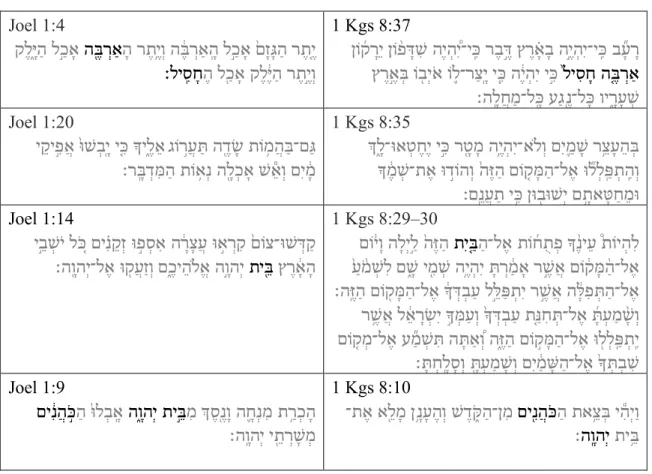
10, 12 and Isaiah 24:7, 9, 11
The theme of both passages has some similarities—the desolation of the land, the wasting of its fruit, and the taking of joy from men—although the picture in Isaiah 24 is more removed from historical events than the concrete occurrence of a locust. plague and drought in Joel 1. Although Joel 1:10 does not use the same subjects of the verbs לבא and למא as Isaiah, its text is more extensive than Isaiah 24:7, where it reads רהציללמאשׁוריתשׁיבוהןגדדדשׁי כהמדאהלבאהדשׂדדשׁ. All the words in the first half of the Isaiah verse are found in these verses in Joel,” but he does not explore it further.85 Hugh Williamson lists a number of parallel passages between Isaiah 24-27 and other prophetic texts that claim that the borrower often generalizes his source texts.
In connection with this study, he dates Isaiah 24:1–20 to "the threshold of the destruction of Jerusalem in the year 587".88 Christopher Hays dates this section even earlier. Joel's initial message (1:2–14) attempted to communicate the importance of the locust plague to his contemporaries. Hays, “Isa 24–27 and Zephaniah amid seventh-century terrors and hopes: an intertextual analysis,” in Isaiah and the Twelve: Perspectives, Similarities and Differences, ed.
Brian Doyle, The Apocalypse of Isaiah Metaphorically Speaking: A Study of the Use, Function, and Significance of Metaphors in Isaiah 24–27, BETL 151 (Leuven: Leuven University Press. Throughout Isa 24:1–20 the interweaving of human and natural imagery and illustrates the interconnected fate of the land and its people.96.
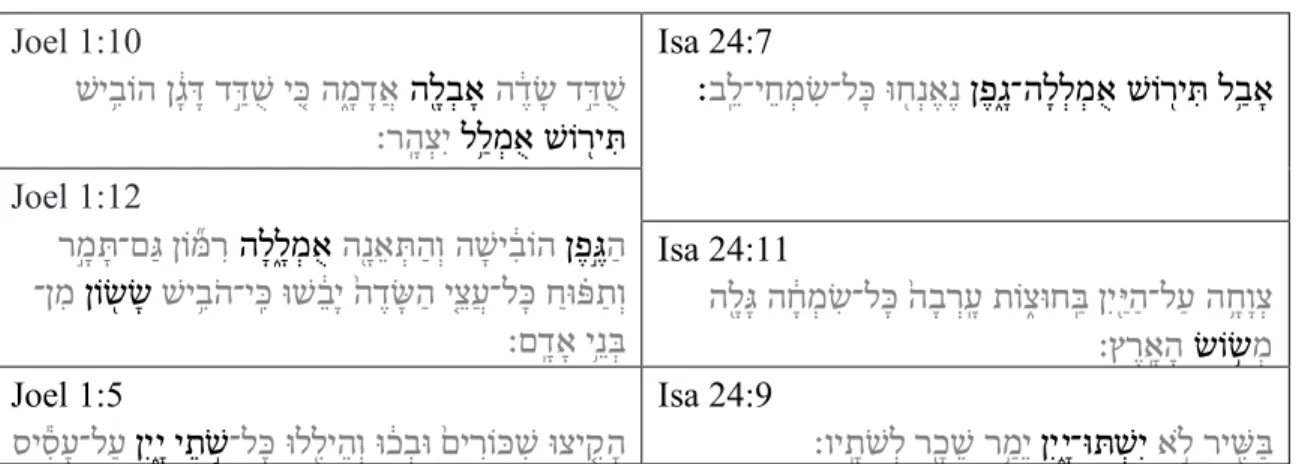
The Day of the Lord has often been described as the central and unifying theme of the book of Joel.99 The phrase הוהיוי appears more than any other in Joel. Williamson, "The Day of the Lord in the Book of Isaiah and the Book of the Twelve," in Isaiah and the Twelve: Parallels, Similarities and Differences, ed. Mowinckel also argues for the origin of the Day of the Lord within the cult around a.
This connection to creation and the day of the Lord is found outside of the minor prophets. Determining the origin of the Day of the Lord is less important to this study than understanding how it is used in Joel. The Lord's Day is therefore a fitting theme for Joel to take up in bringing together his themes of covenant and creation.
If Joel simply wanted to mention the Lord's Day, there were phrases available. Joel does not refer to the eighth plague as a sign of the ninth/tenth plague, but as a sign of the day of the Lord.
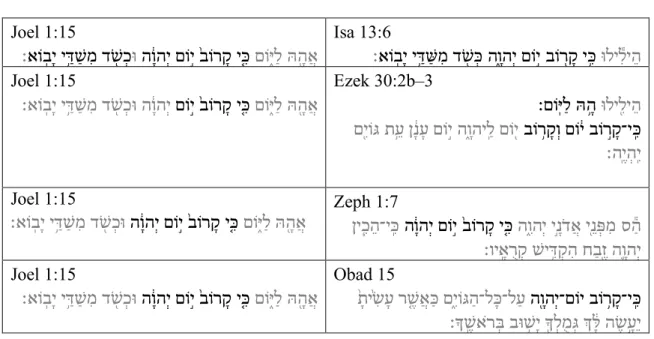
Goulder dates Psalm 42, as part of the Elohistic Psalter, to the eighth/ninth century as coming from the northern kingdom. Some therefore understand 42:8 as an insertion due to the use of the divine name YHWH. The people do not need a physical pilgrimage to the temple, but a spiritual pilgrimage back to the God of the temple.
Third, Joel considers the importance of the temple only insofar as it points to the divine reality of YHWH's presence. Such destruction in Isaiah 24 resulted in a newly created order, something not yet seen in Joel, since the day of the Lord has not yet come. This Day of the Lord in Joel is presented as an imminent, climactic and final punishment for Israel after the plague of locusts.
In these stories, the plague of locusts was a precursor to the scourge of darkness and the last, the death of the firstborn. YHWH's dark day following Joel's plague of locusts is similar to the plagues of darkness and the death of the firstborn after the locust.
